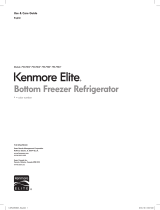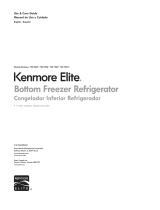
12 INSTALLATION
Unpacking the Refrigerator
Water
Electricity
Flooring
Ambient Temperature
NOTE
NOTE
NOTE
• Use two or more people to move and install the
refrigerator. Failure to do so can result in back
injury or other injury.
• The refrigerator is heavy. Protect the oor when
moving the refrigerator for cleaning or service.
Always pull the refrigerator straight out when
moving it. Do not wiggle or walk the refrigerator
when trying to move it, as oor damage could
occur.
• Keep ammable materials and vapors, such as
gasoline, away from the refrigerator. Failure to
do so can result in re, explosion, or death.
• The water pressure must be 20 - 120 psi or 138 -
827 kPa or 1.4 - 8.4 kgf/cm2. If the refrigerator is
installed in an area with low water pressure
(below 20 psi or 138 kPa or 1.4 kgf/cm2), you can
install a booster pump to compensate for the
low pressure.
• Installing on carpeting, soft tile surfaces, a
platform or weakly supported structure is not
recommended.
• Do not overload house wiring and cause a re
hazard by plugging in multiple appliances in the
same outlet with the refrigerator.
• To reduce the risk of electric shock, do not install
the refrigerator in a wet or damp area.
Water supply must be easily connected for the
automatic icemaker.
Use an individual, grounded outlet: 230 Volts, 50
Hz, AC, 15 Amps minimum.
To avoid noise and vibration, the unit must be
installed and leveled on a solidly constructed oor.
If required, adjust the leveling legs to compensate
for the unevenness of the oor.
Install this appliance in an area where the
temperature is between 55 °F (13 °C) and 110 °F
(43 °C).
If the temperature around the appliance is too low
or high, cooling ability may be adversely aected.
• Remove tape and any temporary labels from
your refrigerator before using. Do not remove
any warning labels, the model and serial number
label, or the Tech Sheet that is located under the
front of the refrigerator.
• To remove any remaining tape or glue, rub the
area briskly with your thumb. Tape or glue
residue can also be easily removed by rubbing a
small amount of liquid dish soap over the
adhesive with your ngers. Wipe with warm
water and dry.
• Do not use sharp instruments, rubbing alcohol,
ammable uids, or abrasive cleaners to remove
tape or glue. These products can damage the
surface of your refrigerator.
• Reinstall or adjust shelves as needed.
Refrigerator shelves are installed in the shipping
position. Reinstall shelves according to your
individual storage needs.
Choosing the Proper
Location
WARNING
WARNING






















